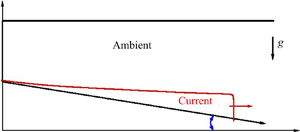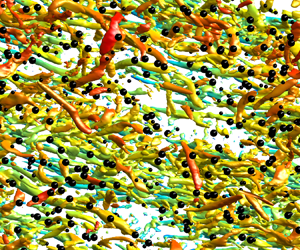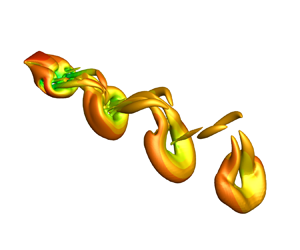doi:10.1017/jfm.2024.514 Kumar & Premachandran Flow film boiling on a sphere in the mixed and forced convection regimes
JFM Rapids
High-flexibility reconstruction of small-scale motions in wall turbulence using a generalized zero-shot learning
-
- Published online by Cambridge University Press:
- 14 August 2024, R1
-
- Article
- Export citation
Fake turbulence
-
- Published online by Cambridge University Press:
- 12 August 2024, R2
-
- Article
-
- You have access
- Open access
- HTML
- Export citation
On a similarity solution for lock-release gravity currents affected by slope, drag and entrainment
-
- Published online by Cambridge University Press:
- 13 August 2024, R3
-
- Article
-
- You have access
- Open access
- HTML
- Export citation
Focus on Fluids
It takes three to tangle
-
- Published online by Cambridge University Press:
- 12 August 2024, F1
-
- Article
-
- You have access
- Open access
- HTML
- Export citation
JFM Papers
Generalizing electroosmotic-flow predictions over charge-modulated periodic topographies: tuneable far-field effects
-
- Published online by Cambridge University Press:
- 12 August 2024, A1
-
- Article
-
- You have access
- Open access
- HTML
- Export citation
Turbulence modulation by charged inertial particles in channel flow
-
- Published online by Cambridge University Press:
- 12 August 2024, A2
-
- Article
- Export citation
Lagrangian-based simulation method using constrained Stokesian dynamics for particulate flows in microchannel
-
- Published online by Cambridge University Press:
- 12 August 2024, A3
-
- Article
-
- You have access
- Open access
- HTML
- Export citation
The impact of non-frozen turbulence on the modelling of the noise from serrated trailing edges
-
- Published online by Cambridge University Press:
- 12 August 2024, A4
-
- Article
- Export citation
Transport of inertial spherical particles in compressible turbulent boundary layers
-
- Published online by Cambridge University Press:
- 12 August 2024, A5
-
- Article
- Export citation
Pore-scale study of CO2 desublimation and sublimation in a packed bed during cryogenic carbon capture
-
- Published online by Cambridge University Press:
- 12 August 2024, A6
-
- Article
-
- You have access
- Open access
- HTML
- Export citation
Deep reinforcement learning finds a new strategy for vortex-induced vibration control
-
- Published online by Cambridge University Press:
- 12 August 2024, A7
-
- Article
-
- You have access
- Open access
- HTML
- Export citation
Thermodynamically consistent diffuse-interface mixture models of incompressible multicomponent fluids
-
- Published online by Cambridge University Press:
- 12 August 2024, A8
-
- Article
-
- You have access
- Open access
- HTML
- Export citation
Perfect active absorption of water waves in a channel by a dipole source
-
- Published online by Cambridge University Press:
- 12 August 2024, A9
-
- Article
-
- You have access
- Open access
- HTML
- Export citation
Dynamics of particle aggregation in dewetting films of complex liquids
-
- Published online by Cambridge University Press:
- 12 August 2024, A10
-
- Article
-
- You have access
- Open access
- HTML
- Export citation
Dynamics of weighted flexible ribbons in a uniform flow
-
- Published online by Cambridge University Press:
- 14 August 2024, A11
-
- Article
- Export citation
Resonant standing surface waves excited by an oscillating cylinder in a narrow rectangular cavity
-
- Published online by Cambridge University Press:
- 14 August 2024, A12
-
- Article
-
- You have access
- Open access
- HTML
- Export citation
Inertial particle focusing in fluid flow through spiral ducts: dynamics, tipping phenomena and particle separation
-
- Published online by Cambridge University Press:
- 14 August 2024, A13
-
- Article
-
- You have access
- Open access
- HTML
- Export citation
Shear-induced depinning of thin droplets on rough substrates
-
- Published online by Cambridge University Press:
- 14 August 2024, A14
-
- Article
-
- You have access
- Open access
- HTML
- Export citation
Experimental study on the settling motion of coral grains in still water
-
- Published online by Cambridge University Press:
- 14 August 2024, A15
-
- Article
-
- You have access
- Open access
- HTML
- Export citation
Cracking of submerged beds
-
- Published online by Cambridge University Press:
- 14 August 2024, A16
-
- Article
- Export citation










































































